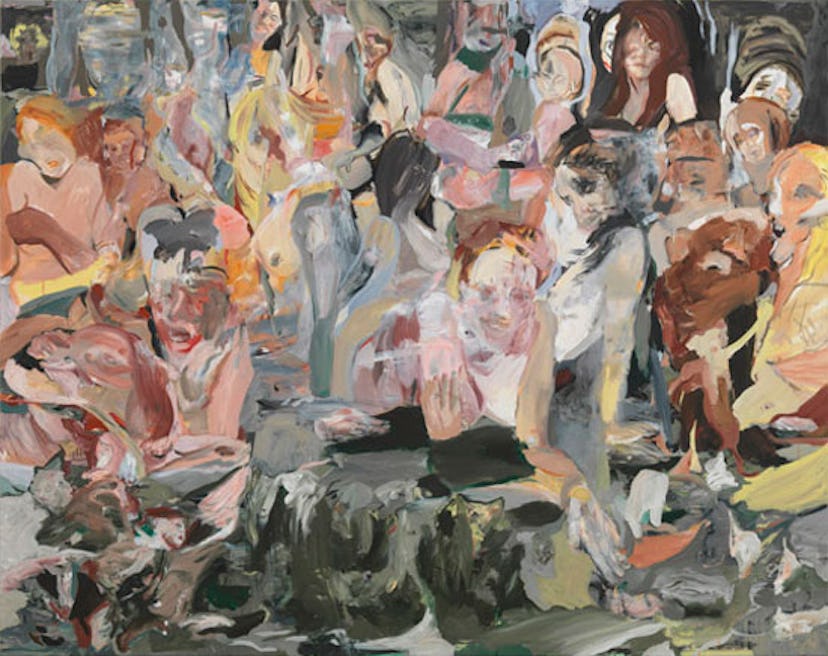Five Minutes With Cecily Brown
Since making her now-considerable reputation as a painter of erotic imagery in the late ’90s, the 43-year old artist Cecily Brown has been working the muddy turf between abstraction and figuration.

Since making her now-considerable reputation as a painter of erotic imagery in the late ’90s, the 43-year old artist Cecily Brown has been working the muddy turf between abstraction and figuration. Critics, for the most part, feel she has drifted more towards the former over the years. But now, with her new solo exhibition opening tonight at Gagosian’s Madison Avenue gallery in New York, the British artist might be making her clearest strides towards the latter. Her first show in New York since 2008 consists of six large canvases featuring groups of variously posed nude women, some of whose faces are distinct, and others who are obfuscated by Brown’s earth-toned paint.
When did you start working on the six paintings that make up this show? I started these two years ago, but the way I work is I start things and then I leave them to start other things. I left these paintings alone for a while before going back because they were making me so uneasy. I needed time to sort of step back from them.
What about them made you uneasy? It’s kind of a jump for me. Crowds of women are quite a lot more figurative than anything I’ve painted for some time. And even though my whole take on the matter is always that there’s no difference between abstraction and figuration—well, in this case, it feels like there is. For me, it became unfamiliar territory once faces appeared in the paintings.
The way they’re arranged in the paintings, it almost feels like you’re combing your memory for faces—some are more in focus, others less so. Right. Actually, I’m in the middle of titling them, and I decided to call one work Name That Tune. My husband asked why, and I explained that it was exactly this sort of feeling—when someone feels vaguely familiar, and faces come and go, in and out of focus. Maybe it’s just my early-onset Alzheimer’s [laughs], but in my more abstract work I’ve always liked the sense of mind and eye collaborating to complete the thought. Ideally, there’s something transporting about looking at them.
Did you call up any of these faces from your own past? They’re not faces of real people, but maybe they’re faces from art. I was painting 13 faces in one group and approaching each in different ways. I’ve always loved Edvard Munch’s women, so I’d paint one like Munch, another like James Ensor, one like Lucian Freud, and then maybe another from memory. But the funny thing about when you’re painting figuratively, you sort of feel slightly more awake in the real world. Every time you look at someone, part of your brain is trying to record and store it: that’s what a cheek looks like from that angle, or those are eyelashes or freckles or whatever. In a really nice way, you feel like everything is turned up high visually.
So you were a bit odd socially during this period? Yeah. [laughs] If you catch me staring closely at your fingernails, you know why.
Why did you decide to focus on nudes of women? That’s kind of a tricky one—it seems like such a loaded topic. There were moments when I worried about whether these are positive views of women. I think that my being conflicted about making nudes of women comes across in the paintings. I don’t even feel like they are really nudes because while there’s plenty of skin, there’s not really anything titillating. They feel melancholic, for the most part.
How do you feel about the idea of the ‘male gaze’? As a woman, you’re used to being looked at in person—well, not as much now as before [laughs]—just like, as a painter, you’re aware of the idea of the male gaze in art. It’s a complicated issue. I never thought I shouldn’t look at a painting of a woman just because it was made by a man. I always looked rather naively, and I always wanted to make paintings that stood apart from any kind of dogma. I do think we’re sort of beyond all that now. Mostly, I’ve just always wanted to keep making work that’s in opposition to whatever came before in my career. That’s why I have a hankering for the figurative now.
Your last solo show in New York, which was mostly abstract and expansive rather than figurative and tightly edited like this one, was five years ago. A lot’s changed for you since then. For one, you had a baby. Exactly, but I don’t think you want to call these the ‘motherhood pictures’. [laughs] They’re not exactly warm and fuzzy. But the way I work now, it’s a bit schizophrenic. Before, I never really had a domestic side at all. Now I have to think about things like lunch and laundry.
Does your daughter Celeste paint? Yes, but probably no more than most four-year olds.
She doesn’t have a defined style yet? No, but if you ask her what something is, she’ll tell you, “It’s abstract.”
Images: © Cecily Brown. Courtesy Gagosian Gallery. Photography by Robert McKeever